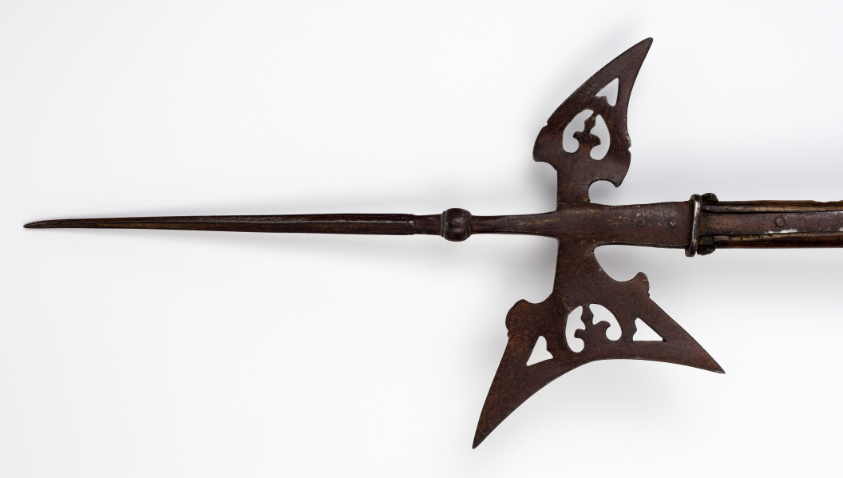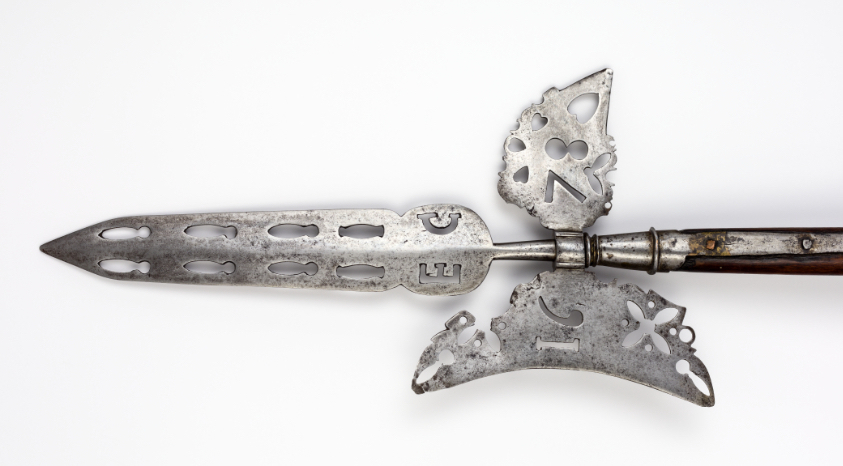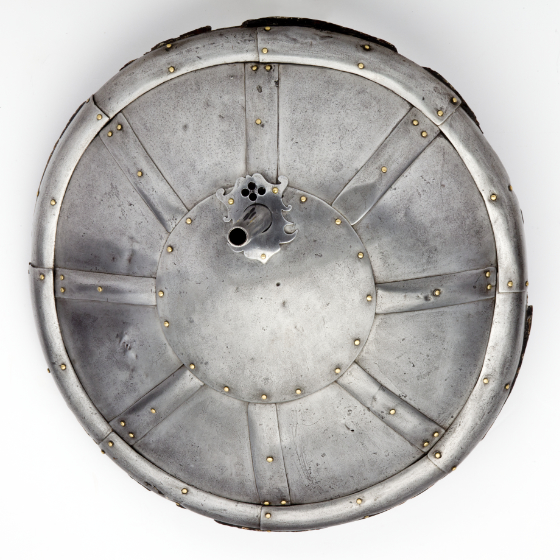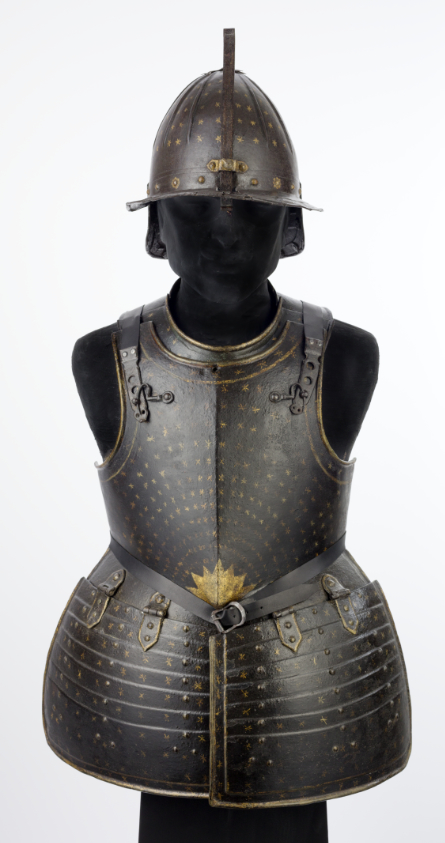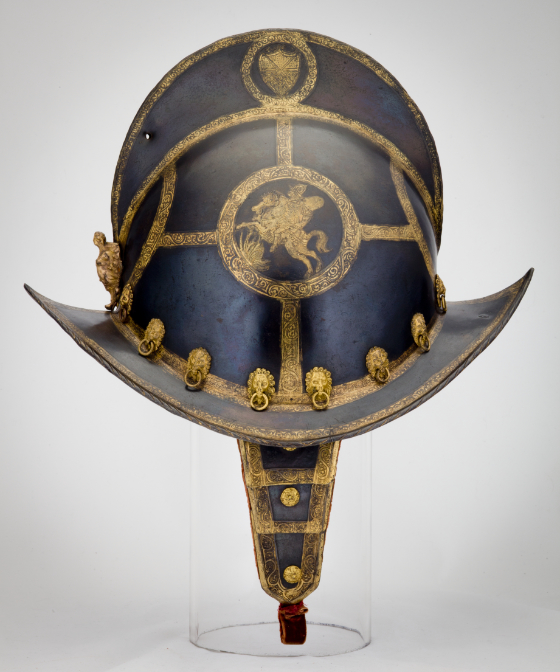By the late 1500s, the increasing use of firearms on the battlefield significantly reduced the effectiveness of armor. To make the steel resistant to musket or pistol balls, armor needed to become increasingly thick, and therefore heavy. This made it impractical for foot soldiers to wear, and they began to focus on protecting only the head and torso. Even soldiers on horseback, who still wore more complete suits of armor, began to forego protection below the knee.
Gunpowder also changed military tactics as armies began to modernize. Charges of heavily armored knights gave way to massed formations of footmen carrying spears or firearms supported by cannons. Cavalry continued to play an important role, but the knights of old had effectively disappeared.
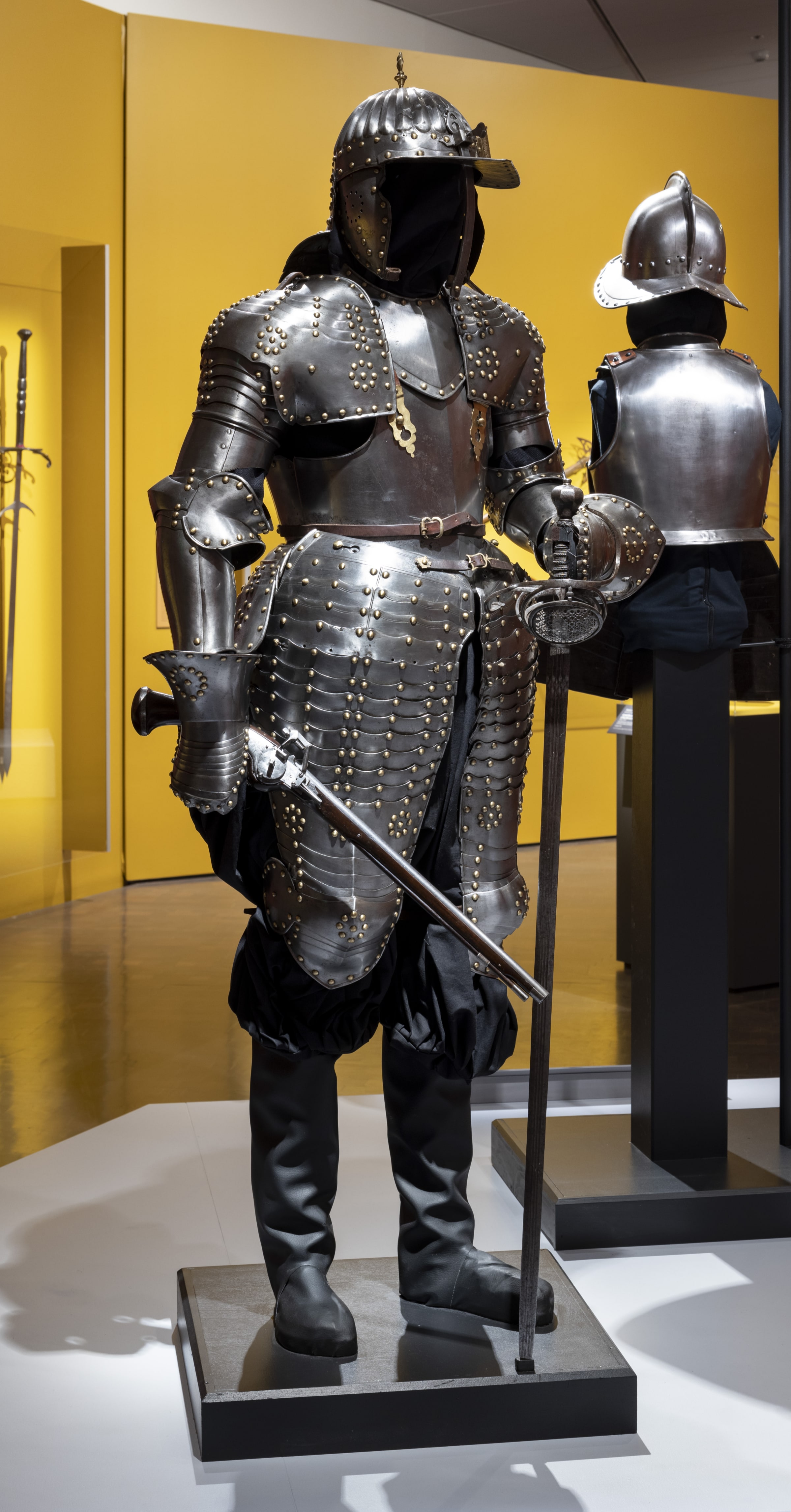
Three-Quarter Armor for a Cuirassier
Augsburg, southern Germany
1620–25
Steel and brass with modern leather
Weight 47 lb. 1 oz.
The John Woodman Higgins Armory Collection, 2014.1135
Pappenheimer Sword
Northern Europe, perhaps the Netherlands
About 1630s
Steel, iron, wire, and wood
Weight 3 lb. 8 oz.
The John Woodman Higgins Armory Collection, 2014.348
Wheel-Lock Holster Pistol
Perhaps Suhl, Germany
About 1625–50
Steel and walnut wood
Weight 2 lb. 6 oz.
The John Woodman Higgins Armory Collection, 2014.376
By 1600, the traditional heavy cavalryman armed with a lance gave way to the cuirassier, so named for his torso armor (cuirass). He carried a sword and a pair of pistols. The helmet, called Zischägge, resembles a Turkish helmet called a chichak. Armor styles in central Europe borrowed heavily from Turkish types in the 1600s, reflecting the importance of the Ottoman Empire in this region as it expanded into southeastern Europe.
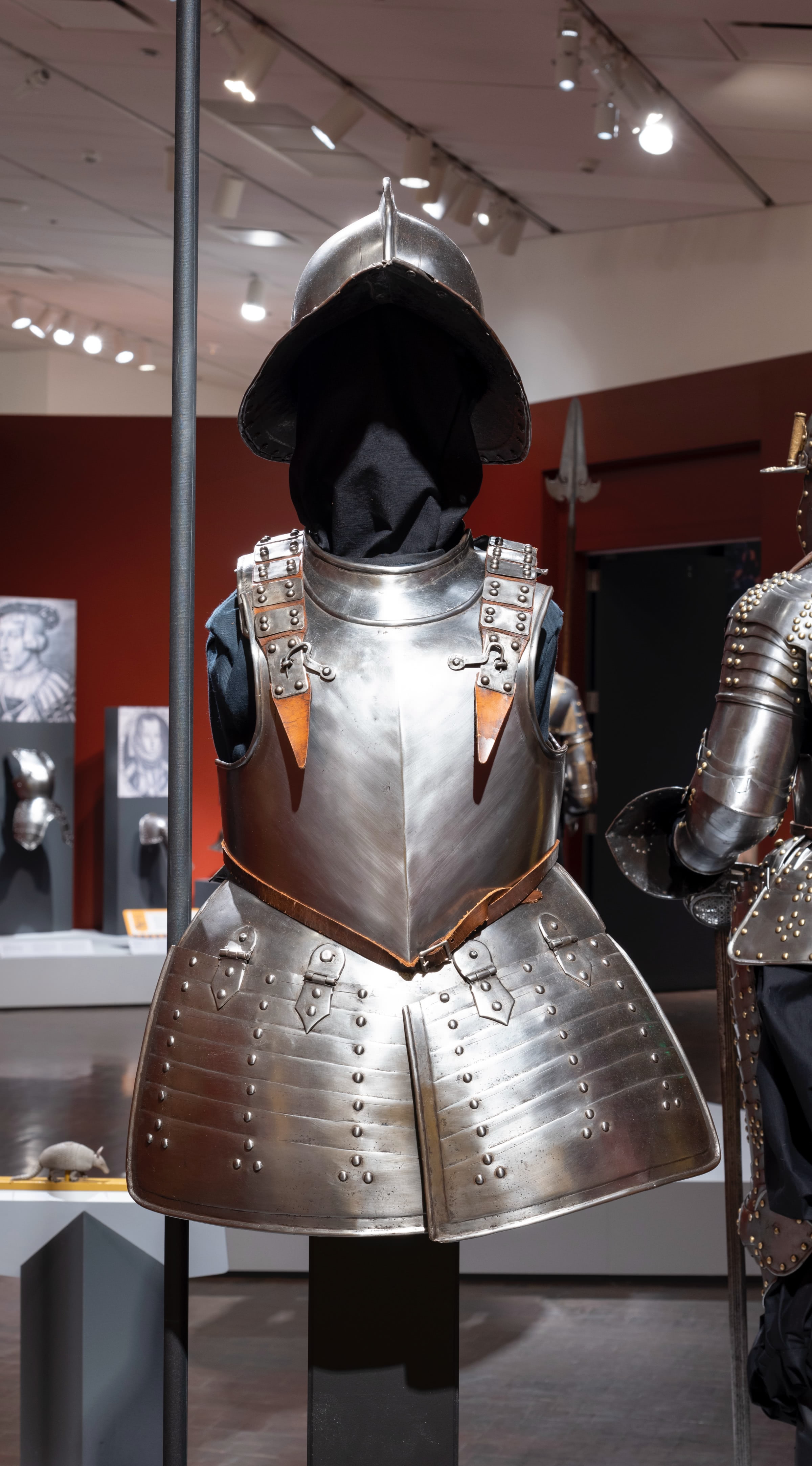
Half-Armor for a Pikeman
England
Helmet probably by Richard Wright
About 1625–45
Steel with modern leather
Weight 14 lb. 8 oz.
The John Woodman Higgins Armory Collection, 2014.1167
Gorget for a Pikemans’ Armor
Netherlands
About 1625–45
Steel
Weight 1 lb.
The John Woodman Higgins Armory Collection, 2014.789
Pikemen carried long spears and fought on foot in porcupine formations to defend musketeers from attacking cavalry. Musketeers, named for the long firearms they carried, wore no armor and needed protection as they reloaded their muskets. Pikemen wore head and torso armor to protect them in close combat.
For Show
Halberd
Perhaps England
Early 1600s
Steel and wood
Weight 4 lb. 4 oz.
The John Woodman Higgins Armory Collection, 2014.124
Image © 2021 Worcester Art Museum, all rights reserved
Halberd for a “Trained Band”
Present-day Massachusetts
1678
Steel and wood
Weight 3 lb. 12 oz.
The John Woodman Higgins Armory Collection, 2014.69
Image © 2021 Worcester Art Museum, all rights reserved
In the late Middle Ages, soldiers employed halberds to fight mounted knights. By the 1600s, they had become a badge of office for an infantry sergeant. The axe and beak on this example are no longer functional. Only the thrusting tip would have been usable in combat. This example displays the year 1678 and belonged to a sergeant in a trained band, a militia maintained by every New England community. Halberds were used in America as late as the Revolutionary War.

Ceremonial Two-Handed Sword
Germany
About 1600
Steel, wood, leather, and textiles
Weight 7 lb. 15 oz.
The John Woodman Higgins Armory Collection, 2014.126
Image © 2021 Worcester Art Museum, all rights reserved
This sword represents the upper size limit for battlefield swords, but it was probably never swung in combat. Two-handed swords reached the height of their use as weapons of war by 1500. By the time this one was made, they served chiefly for ceremonial purposes, carried by the entourages of political and military leaders.
Target (Shield) with Breech-Loading Gun
Perhaps Italy
About 1540
Wood, steel, tinned iron, brass, fabric, and paint with modern restorations
Weight 9 lb. 10 oz.
The John Woodman Higgins Armory Collection, 2014.768
Image © 2021 Worcester Art Museum, all rights reserved
Henry VIII of England, always interested in the latest military technology, purchased many gun-shields like this one. Although innovative, these weapons were never successful as military gear. The design required that the gun be loaded from the rear, or breech. However, Renaissance technology couldn’t create a perfect seal when closing the breech—a dangerous possibility that could cause the gunpowder to explode in the wrong direction. Breech-loading weapons weren’t common until the late 1800s.

Matchlock Musket
Probably Germany
About 1600
Steel and walnut wood
Weight 12 lb. 4 oz.
The John Woodman Higgins Armory Collection, 2014.13
By 1600, powerful firearms like this musket dominated European battlefields and were a real threat to armored soldiers. Musket shot could pierce most armor. However, the weapon was heavy and awkward to use. When the shooter grasped the trigger, a slow-burning match-cord clamped on the side of the musket rotated into place to ignite the gunpowder in the “pan” at the top of the musket, firing the weapon.
Master HW
German, 1630–1680, active in Nuremberg
Pair of Wheel-Lock Holster Pistols
About 1650
Steel, snakewood, bone or horn, and gilt brass
Weight 2 lb. 8 oz. (each)
The John Woodman Higgins Armory Collection, 2014.433.1-2
By the 1600s, armored heavy cavalry were abandoning the lance. Instead, they kept a pair of pistols at the front of their saddles. They would ride close to their target to discharge their pistols, then circle around again to charge with swords drawn. This exceptionally decorative pair must have belonged to a wealthy horseman.
Dented
Sapper’s Helmet
Switzerland
1600s
Painted steel and leather
Weight 19 lb. 14 oz.
The John Woodman Higgins Armory Collection, 2014.1106
Breastplate from a Siege Cuirass
Probably Germany or Austria
1590–1600
Painted steel and brass
Weight 24 lb. 10 oz.
The John Woodman Higgins Armory Collection, 2014.4.1
Though impractical for field combat by the 1600s, armor continued to be used for siege operations, where mobility was less important. The dent in this heavy helmet is probably a proof mark from the maker, demonstrating that the steel was capable of resisting a musket-shot. The thick steel of the breastplate provided excellent protection against bullets, but it was too heavy for a soldier marching on a battlefield. Multiple bullet marks on the surface suggest this breastplate saved its owner’s life more than once.

Gorget
Germany
1590–1610
Steel and leather
Weight 2 lb. 15 oz.
The John Woodman Higgins Armory Collection, 2014.788
Gorget for an Officer of the City Militia
Netherlands
Late 1700s
Gilt brass
Weight 7 oz.
The John Woodman Higgins Armory Collection, 2014.5
Officer’s Gorget
Great Britain
1770s
Silver
Weight 3 oz.
The John Woodman Higgins Armory Collection, 2014.786
Image © 2021 Worcester Art Museum, all rights reserved
Gorgets are neck guards, originally worn under torso armor to help distribute its weight. After 1600, many soldiers stopped wearing torso armor, but some officers continued to wear the gorget as a military fashion statement. The once plain, but protective, piece of armor became a decorative adornment, and soldiers wore a smaller version of the gorget as a badge of rank as late as the American Revolution.
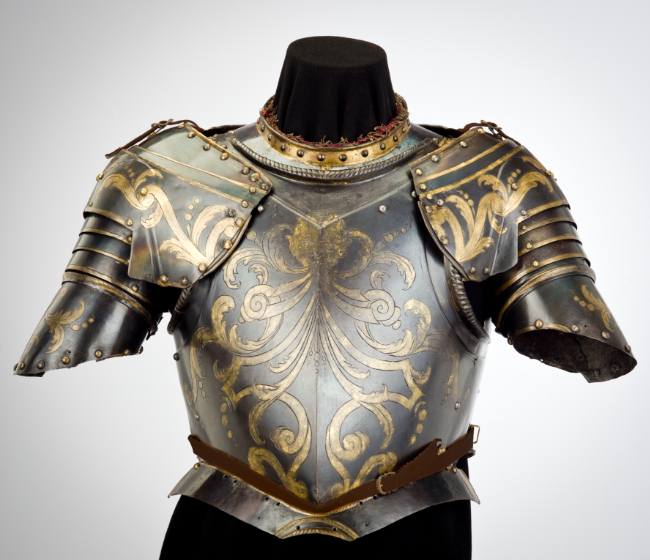
Half-Armor for a Member of the Papal Guard
Perhaps Brescia, northern Italy
1570–90
Fire-blued and engraved steel with gilding, brass, and modern leather
Weight 17 lb. 2 oz.
The John Woodman Higgins Armory Collection, 2014.1137
Image © 2021 Worcester Art Museum, all rights reserved
This armor belongs to a group of similar suits, repurposed from combat armor, and decorated for use by the Papal Guard. None of the surviving examples have helmets—they were probably meant to be worn with a stylish hat.
Pikeman’s Armor with Helmet for a Harquebusier
Netherlands
About 1625–50, decorated in 1700s
Painted steel with modern leather
Weight 16 lb. 10 oz.
The John Woodman Higgins Armory Collection, 2014.1132
Image © 2021 Worcester Art Museum, all rights reserved
As armor lost its military value, stockpiles of old armor gathered dust in the armories of European kings and noblemen. This torso armor for a foot soldier and helmet for a cavalryman were probably once in the British Royal Armouries. They appear to have been pulled out of storage in the 1700s and decorated for a ceremonial occasion.
Master MR
German, active in Nuremberg, late 1500s
Comb Morion for the Guard of the Electors of Saxony
About 1590
Heat-blackened, etched, and gilded steel with brass, textile, and leather
Weight 4 lb.
The John Woodman Higgins Armory Collection, 2014.48
Image © 2021 Worcester Art Museum, all rights reserved
This helmet had a noble beginning and an artful end. The electors of Saxony were powerful German princes who maintained a personal guard of two hundred horsemen and foot soldiers. These troops wore matching armor and clothing, black with gold decoration, imitating the colors of the Saxon coat of arms. In the 1800s, much of it was given away or sold. Numerous helmets like this one were sent to the Dresden opera house for use as props.

Keyhole Plate made from a Breastplate
Probably Milan, northern Italy
About 1555-60
Etched and heat-blackened steel
Weight 2 lb., 14 oz.
The John Woodman Higgins Armory Collection, 2014.682
Image © 2021 Worcester Art Museum, all rights reserved
When armor became obsolete, it might lie neglected in a nobleman’s armory, but it was more likely to be cut up for scrap. This object was once a highly decorated breastplate but was later cut down and hammered flat to serve as a keyhole plate for a large door.

Age of Armor: Treasures from the Higgins Collection at the Worcester Art Museum is organized by the Worcester Art Museum. Support is provided by the donors to the Annual Fund Leadership Campaign and the residents who support the Scientific and Cultural Facilities District (SCFD). Promotional support is provided by 5280 Magazine and CBS4.
